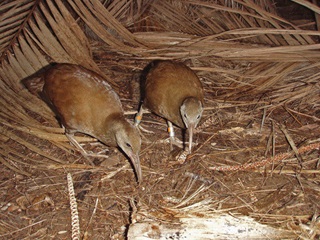
These birds are found only on Lord Howe Island, a World Heritage Area, which lies in the south-western Pacific Ocean around 700 kilometres east of Port Macquarie.
Before European colonisation, the species was spread throughout Lord Howe Island, populating the different subtropical rainforest environments. They could be found in a range of environments, from low-lying palm forests to mountain-top mist forests. They eat worms, molluscs and other invertebrates.
What do they sound like?
Lord Howe woodhens vocalise with a variety of high-pitched staccato calls. The territorial call consists of a series of loud, piercing notes given at any time of the day or night. When alarmed, the species may give a loud, long piercing note and, to maintain contact, individuals make a low, resonant grunting or purring.
What do they eat?
 Lord Howe woodhens feed on different types of insects, worms and other small creatures found in the forest.
Lord Howe woodhens feed on different types of insects, worms and other small creatures found in the forest.
Breeding
Adult Lord Howe woodhens pair for life, and each pair defends a territory of around 3 hectares. The breeding season is between spring and early summer and, although most birds mate, a significant proportion of them do not successfully produce young. Nests are built in petrel burrows or in the hollows under tree roots, using grass, moss and palm fibre.
Because Lord Howe woodhens are territorial, their population is dependent on the number of breeding pairs that can be accommodated in any given area. Young adult birds will be expelled from their parents' territory. If they cannot take the place of an adult that has died, they will be forced to move to another area to find their own feeding grounds.
A tragic history
The ancestors of the Lord Howe woodhen arrived on Lord Howe Island many thousands of years ago, flying across the Pacific Ocean. They thrived in the subtropical rainforests of the island, where there was plenty of food and no fear of predators. Their wings gradually receded and became useless because there was no longer any need for them to fly.
This situation changed in 1788, when HMS Supply anchored at Settlement Beach and members of the crew came ashore in search of food and water. Lord Howe Island's bird life had never been hunted and was not afraid of humans. The Lord Howe woodhen, together with the now-extinct Lord Howe pigeon and white gallinule, provided easy game for the sailors.
Lord Howe Island was settled in 1833–34 and Lord Howe woodhen numbers quickly declined to near-extinction because:
- they were hunted for food by the island's increasing human population
- introduced owls, feral cats and pigs preyed on them
- feral pigs and goats competed with the birds for food and damaged their habitats.
By the mid-19th century, only small numbers of Lord Howe woodhens could be found in relatively inaccessible mountainous areas. By the late 1970s, there were fewer than 30 Lord Howe woodhens on the island. The birds were confined to the summit regions of its two mountains: Mount Gower and Mount Lidgbird.
In 1966, the International Union for the Conservation of Nature (IUCN) classed the woodhens as endangered. They were later put on the IUCN's highest priority list.
The bird is listed as an endangered species under the NSW Biodiversity Conservation Act 2016 and the Commonwealth Environment Protection and Biodiversity Conservation Act 1999.


